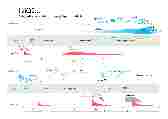Lài Qu ...
- für Zheng and Live-Elektronik
- Dauer: ca. 12 min.
- 2001 Komposition von Yueyang Wang und Andre Bartetzki
Lài Qu... ist eine Gemeinschaftskomposition der Komponistin und Zheng-Spielerin Yueyang Wang (Berlin/Beijing) und mir.
Aufführungen
Das Stück wurde während des Festivals Kryptonale 2001 in Berlin uraufgeführt.
Yueyang Wang und ich spielten Lài Qu... zusammen mehrere Male in Berlin, zum Festival Randspiele sowie zur ICMC2002 in Göteborg/Schweden.
Beim Festival SICMF2003 in Seoul/Korea habe ich das Stück zusammen mit JiYeon Koh in einer Version für koreanisches Kayageum gespielt
Eine Aufnahme von Lài Qu... erschien auf der CD der Internationalen Computer Music Conference ICMC2002 (LJCD5232 www.lj-records.se).
Bild- und Klangbeispiele
 |
 |
 |
 |
| Gu-Zheng | Yueyang 1 | Yueyang 2 | grafische Partitur |
Hörbeispiel (zheng - Yueyang Wang, electronics - Andre Bartetzki):
Anmerkungen zum Stück
Das Zheng, eine Zitter, gehört zu den populärsten Musikinstrumenten Chinas, dessen älteste Formen 2500 Jahre alt sind. Ursprünglich bestand das Gu-Zheng aus einem Bambusrahmen und 5 Saiten aus Seide, die inzwischen von Nylonsaiten abgelöst wurden. Die Stimmung ist pentatonisch: DO RE MI SO LA. Der Umfang des Instruments wurde vor allem in der Tiefe erweitert und erreicht bei heutigen Konzertinstrumenten 21-25 Saiten. Jede der Saiten wird über einen eigenen verschiebbaren Steg geführt, dessen Höhe die für die traditionelle Musik typische Vibrato- und Glissandotechnik ermöglicht.
Eng mit dem Zheng verwandt sind die japanische Koto, das vietnamesische Dan Tranh sowie das koreanische Kayageum.
Während der Aufführung von Lài Qu ... (sprich: Lai-Tschü) werden die Klänge des Zheng in Echtzeit durch verschiedene live-elektronische Prozesse mit Hilfe der Software SuperCollider transformiert. Einige vorher aufgenommene Klänge, die zumeist ebenfalls vom Zheng stammen, ergänzen diese Prozesse. Die mehrkanalige Elektronik erweitert den inneren Raum des Instruments, so dass der Zuhörer von ihm umgeben ist. Schließlich verbinden sich traditionelle und ungebräuchliche Spieltechniken, Instrumentalklang und Live-Elektronik, lineare Melodik und vertikale Spektren zu Farben und Bildern, zu einer abstrakten Landschaft.
Anmerkungen zur Realisation
Das Zheng wird mit einem Kontaktmikrophon versehen und benötigt außerdem ein Kondensatormikrofon oberhalb der Saiten. Die Klänge des Instruments werden mit Hilfe von SuperCollider auf einem Apple-Rechner aufgenommen und transformiert. Neben diese live bearbeiteten Sounds gibt es einige vorproduzierte Klangelemente, die ebensfalls von SuperCollider abgespielt werden. Die Bearbeitung der Klänge wird über eine MIDI-Faderbox gesteuert.
Lài Qu ... ist für 8 Kanäle vorgesehen, kann aber auch mit nur 6 oder 4 Lautsprechern aufgeführt werden.
Review des Konzerts zur ICMC2002
ICMC 2002 Concert Reviews
Gothenburg, Sweden
Thursday night, September 19, 2002
This concert was held in the New Örgryte Church, a gorgeous venue dating from the 1880's and renovated in the past decade. Elegant stenciling adorned the walls and ceiling of the interior, but the showpiece was a magnificent reproduction of a 17th-century North German baroque organ rising behind the audience. About 4.7 million EUR went into a collaboration with engineers from nearby Chalmers University of Technology to research and painstakingly reconstruct the instrument by faithfully modeling the principles of the original in order to achieve a historically accurate sound. On stage at the other end of the space, huge battered speakers hung in ominous contrast with this prevailing architectural grace. However, as the curator of the concert remarked, the music, though produced via technological means, all reflected a spiritual or inspiring quality worthy of the edifice.
(...)
Lài Qu by Yueyang Wang and Andre Bartetzki for zheng and electronics also skillfully blended electric and acoustic. The zheng is so subtle that even in the first row it was difficult to discern the unamplified instrument. Wang turned this potential liability to her advantage, working deftly with the microphone and pickup to transform her palette with great sensitivity. For those of us unfamiliar with the zheng, it was often challenging to tell which sounds were generated by the electronics and which were straight acoustic. Overall there was a well-balanced blend of real-time processing augmenting a variety of unique instrumental colors. Some especially arresting moments occurred when Wang rubbed the strings, a very light sound almost like breathing, above a faint atmosphere of deep resonance. The piece developed gradually, growing from delicate beginnings to a large finale, each material consistently flowing into the next in well-paced increments. The result was entrancing until the very end when prerecorded traffic and city noise completely broke the spell. There was no precedent for these sounds, no contextualization for their intrusion, so they simply sounded wrong. Perhaps this was the composer's intent-modern life overwhelms the spirit-but if so, it was executed with such heavy-handedness that it ruined an otherwise wonderful piece.
(...)
Reviewed by John Young & Margaret Schedel
For the complete article see: ICMA - Array